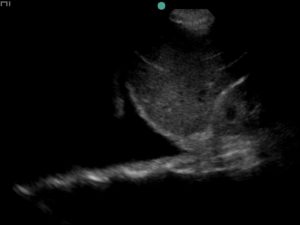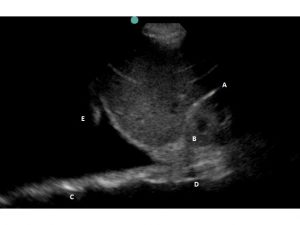A middle-aged male presented to the ED with 2 weeks history of increasing exertional dyspnea. Air entry was reduced clinically. A focused bedside ultrasound demonstrated the above findings. What artifact is missing?
1.The “normal” mirror image of the liver above the diaphragm is missing! It is reassurring when present. The air in normal lung reflects about 99% of the ultrasound beam (i.e. you can’t see past the diaphragm, hiding all normal structures below it). So what’s above the diaphragm is an artifical reflected image of the liver or spleen, thanks to the diaphragm which behaves as a specular reflector (see below). In this case, massive pleural effusion replaces the normal aerated lung, allowing the ultrasound beam to shine through, revealing the vertebral column “C” that was not normally seen. In addition, a tongue of atelectatic lung “E” is found sticking into the pleural fluid, and the superior edge of the diaphragm also well defined
2. Closer look at the vertebral column shows that it is brighter above the diphragm than below. Why? Fluid attenuates ultrasound beam energy less than soft tissue. Therefore, more ultrasound energy passes through fluid than soft tissue for the same distance travelled. So there is actually a stronger ultrasound beam reflected back at “C” compared to “D” , thus making it look brighter. This artificial “brightness” is termed acoustic enhancement. In fact, all clear fluid structures is expected to demonstrate acoustic enhancement.
3. Why did the gerota’s fascia seems to disappear as we trace it from “A” to “B”? Anatomically, it didn’t. That’s an artifact from reflection. Fascia (like the diaphragm) form brightly reflective tissue interface (termed specular reflectors) as opposed to soft tissues (which are diffuse reflectors, having a grey appearance). At “A”, the approaching ultrasound beam hits the specular reflector head on, around 90 degrees. Acting like a mirror, the fascia reflects significantly more ultrasound beam back to the transducer, making it look bright. On the other hand, at “B”, the beam hits it at a much shallower angle. This fasica readily bounces the beam away from the transducer to the left side of the image instead of mostly back towards the transducer, thus making it look dark.
When something unreal is missing, something real may be happening.


